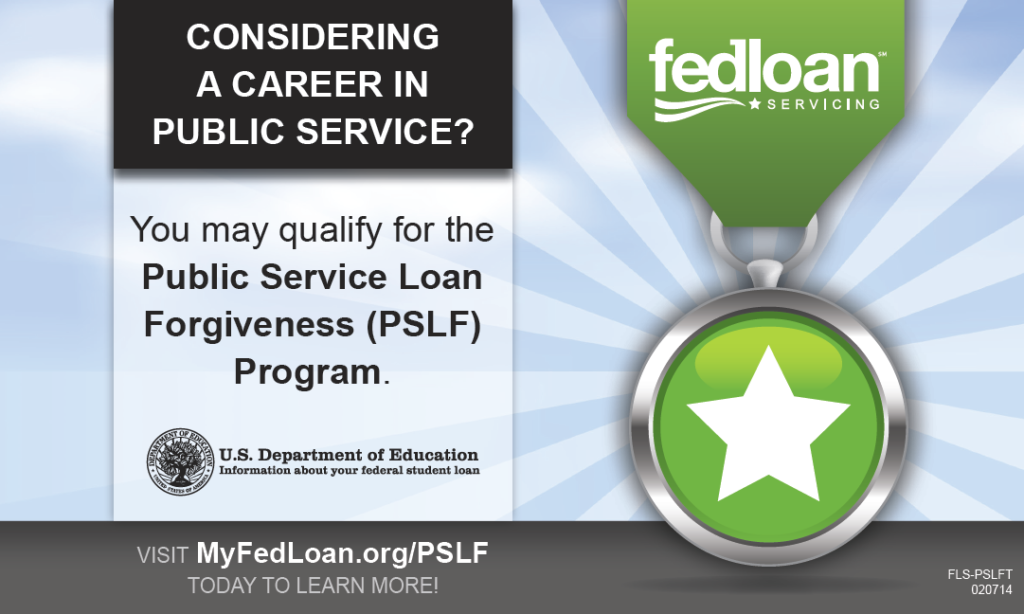 Did you know that there is one broad, employment-based forgiveness program for federal student loans? Let me break down some key points of Public Service Loan Forgiveness (PSLF) to help you figure out if you could qualify.
Did you know that there is one broad, employment-based forgiveness program for federal student loans? Let me break down some key points of Public Service Loan Forgiveness (PSLF) to help you figure out if you could qualify.
Work for a government or non-profit organization
Qualifying for Public Service Loan Forgiveness is not about your job, it’s about who your employer is. In order to qualify for Public Service Loan Forgiveness, you must work for a “public service” employer. What does that mean? Everyone has a different definition.
Employers who qualify based on our definition:
- Government organizations: This includes federal, state, local, and tribal government agencies and organizations.
- Not-for profit organizations: This includes all 501(c)(3) organizations and some other not-for-profit organizations that provide specific public services, such as public education or public health.
Teachers: You may qualify for PSLF even if you don’t qualify for teacher loan forgiveness.
Employers that don’t qualify:
- Labor unions
- Partisan political organizations
- For-profit organizations
Work full-time
You must also be a full-time employee in order to qualify for Public Service Loan Forgiveness. For us, that means you either meet your employer’s definition of “full-time” or work at least 30 hours per week, whichever is greater.
Have Direct Loans (or consolidate other federal student loans to qualify)
Not having a Direct Loan is a big reason why borrowers aren’t on track for PSLF. Many borrowers don’t even realize there are different types of federal student loans, so do your homework.
A qualifying loan is a Direct Loan. If you took out our student loans before 2011, there’s a good chance that some or all of your loans aren’t Direct Loans. If that’s the case, don’t despair! You can consolidate your federal student loans into a Direct Consolidation Loan and qualify for PSLF.
If you don’t know what loan types you have, read this to find out.
Repay your loans on an income-driven repayment plan
For Public Service Loan Forgiveness, you’ll want to repay your loans on one of our income-driven repayment plans:
- Revised Pay As You Earn Repayment Plan (REPAYE Plan)
- Pay As You Earn Repayment Plan (PAYE Plan)
- Income-Based Repayment Plan (IBR Plan)
- Income-Contingent Repayment Plan (ICR Plan)
Read this to decide which income-driven repayment plan to choose.
You can apply for an income-driven repayment plan on StudentLoans.gov.
If you’ve been making payments under the 10-year Standard Repayment Plan, those qualify, but you still need to get on an income-driven repayment plan or your loan will be paid off before you can get forgiveness. That’s because Public Service Loan Forgiveness forgives the remaining balance on your loans after 120 payments (10 years), while the 10-year Standard Repayment Plan sets your payment at an amount that will ensure that your loan is paid off within 10 years.
Make 120 qualifying payments (10 years of payments)
Lastly, you need to make qualifying payments—120 of them. 120 payments is 10 years of payments. A qualifying payment is exactly what you think it is. You get a bill. It has an “amount due” and a “due date”. Make your full payment by the due date (or up to 15 days later if you slipped up and forgot to make your payment), and the payment qualifies. If you make a payment when you’re not required to—say, because, you’re in a deferment—then it doesn’t count. The best way to set yourself up for success is to sign up for automatic payments with your servicer.
Your payments do not need to be consecutive. So, if you make qualifying payments, stop, and then start again, you don’t start over.
Lastly, a payment only qualifies if it was made after October 1, 2007, so nobody can qualify until 2017 at the earliest.
Submit the Employment Certification Form early and often
Given the specific requirements of the program, it can be tricky to figure out if you’re on the right track. Good news is, there’s an easy way to find out:
- Download this form and fill it out.
- Have your employer certify it.
- Send it to FedLoan Servicing (one of our federal student loan servicers).
FedLoan Servicing will then process your form and let you know whether your employment qualifies, and how many qualifying payments you’ve made.
Submit the form early and often. We recommend once per year or when you change jobs. Why? Because it means that you won’t have to submit 10 years’ worth of forms when you ultimately want to apply for forgiveness. It also means that you can apply for forgiveness with confidence.
Okay, so do I qualify?
Now, let’s put it all together. For any payment to count toward PSLF, you need to meet all of the criteria when you make each payment. That means you need to be working full-time for a qualifying employer when you make a qualifying payment on a Direct Loan under a qualifying repayment plan. If you think you meet those requirements submit this form to confirm you’re on track.
One more piece of good news: unlike some other forms of student loan forgiveness, PSLF is tax-free.
The US Department of Education web site provides additional information about public service loan forgiveness.
